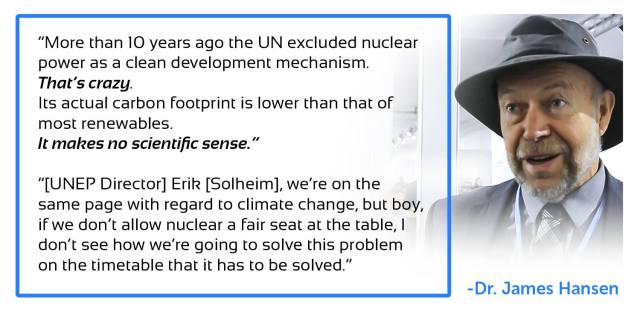 World’s energy production needs all the innovation it can get, but UN-director Erik Solheim appears not to have gotten the memo.
World’s energy production needs all the innovation it can get, but UN-director Erik Solheim appears not to have gotten the memo.
GUEST AUTHOR: This piece was written by journalist Øystein Heggdal, and it was originally published in the Norwegian newspaper Klassekampen on the 2nd of February 2018. We cooperated on a translation of the article for it to appear here English.
There is an ongoing petition campaign with the aim to change the politics at UN’s Environmental Program (UNEP) whose director Erik Solheim is. The campaign is lead among others by the climate scientists James Hansen, and it was started in connection to the COP23 climate meeting in Bonn last year. Solheim and the UNEP arranged the largest side-event of the meeting, called Sustainable Innovation Forum, where tech companies could present their ideas about how societies can be steered in a direction that protects the planet and which helps us avoid the problems of climate change.

It was quite the surprise when World Nuclear Association (WNA) was denied access to the event, after first having been accepted as its gold-sponsor (as covered in Forbes and by the Bright New World). Other main sponsors worth noting, whose money was good enough for Solheim and UNEP, were the internal combustion car manufacturer BMW, and energy companies like Orsted and Fortum whose portfolios include coal.
Emissions: status quo
So here we are. UNEP excluded representatives for an industry which, in 2015, produced 31 percent of the global CO2-free electricity. Only hydro made a bigger contribution, with 47 percent. Despite a global building boom of solar and wind power, these energy forms contributed only 12 and 4 percent, respectively. If we add biomass and geothermal as well, all these represent 34 percent of the world’s total electricity production, the rest comes from fossil sources. To make matters worse, electricity generation is just a one fifth of global emissions, and ever since the climate negotiations started, global greenhouse emissions have gone one way: up.
In a sobering and depressing article in The New York Times in January 2018, journalist Eduardo Porter laid it out: at the first climate conference in Toronto in 1988, the temperatures for the last two decades of the 20th century were 0.5 degrees Celsius higher than the average in the century before, and yearly emissions were at 35 billion tons of CO2-equivalents per year.

Graph: Global Carbon Project. Note: there are slightly different ways of calculating total emissions, but all agree on the same rising trend.
When the climate diplomats flew from Paris three years ago, the atmosphere was 1.1 degrees warmer, and the global emissions at just under 50 billion tons. After three years of stable emission levels, preliminary numbers show a further increase of 2 percent for year 2017, and the CO2-concentration of the atmosphere is steadily ticking upward. In other words, there’s no time for complacency. There are no indications that we are on a course to restrict global warming to 1.5 or 2 degrees.
It ought to be clear that we require sustainable innovation in all technologies and a radical overhaul of the world’s energy production, independent of what Solheim or the UNEP feel are correct technologies. But how much innovation has there actually been in the field of energy production in the last hundred years?
Past, present, and future of energy innovation
The big problem is, that a transition in the energy sector is not like the transition between VHS and DVD, or the shift from mobile phones to smartphones. The energy sector includes enormous production systems that may take many decennia to change. Vaclav Smil writes, in his book Energy Transitions, that it took 35 years for coal to go from 5 percent of the world’s energy production to 25 percent. For oil and gas, the time frame was 40 and 55 years. The reason for the longer and longer transition times depends on the constantly increasing scale of electricity consumption, and larger and more complicated systems that must be changed.

Charles Brush’s windmill of 1888, used for generating electricity. Photo: Wikipedia.
The world we live in today was in many ways set on its course over a hundred years ago. Coal power plants, steam generators, dynamos, transformers, and the alternating current were all invented in the last 20 years of the 19th century. Even the first electricity-producing windmills and the first working solar cell are from the 1880’s. If Thomas Edison, George Westinghouse, William Stanley, Charles Parsons, and Charles Fritts had crashed Solheim’s Innovation Forum (for I don’t know if they could have afforded the 1000 dollar entrance fee), they would have nodded knowingly to many of the technologies which power our societies today, even if their efficiency and scale are orders of magnitude larger than they may have envisioned.
The only large scale energy source which would have been radically different from what was known in the 1880s, is the splitting of the element uranium in order to power a thermal power plant.
UNEP has stated that their involvement within nuclear power is limited, and that this is their basis for excluding World Nuclear Association from their event. But the world can neither afford, nor does it have time for such a selective rejection. We require innovation and development within all sectors of energy, and all types of technology which can deliver CO2-free energy must have a seat at the table if we wish to achieve a world radically different from the one invented in the end of the 19th century. Hopefully one which may avoid the worst consequences of further accumulation of CO2 in the atmosphere.

For more articles on climate and energy, and my experiences from Bonn, look here. Even better idea, is to read the short, evidence-dense book Climate Gamble or browse the graphs in their blog.
If you would like to have a discussion in the comments below, please take note of my Commenting policy. In a nutshell:
- Be respectful.
- Back up your claims with evidence.



In my opinion, wind and solar are on the wrong side of the equation. Here is my assessment without all the numbers. I have another version of this comparison with all the number for those who need the numbers, but my numbers are an estimated average that come from several sources that most informed people already read.
Renewable is just too expensive:
.
When it comes to energy, density is the most important criteria to consider. Yes, there are other considerations but when you have energy sources like uranium and thorium that are one million to two million more energy dense than all other equivalent energy sources; coal, oil, gas, wind, solar, biofuels, geothermal, hydro, wood, wave, and any other creative and innovative way to generate electricity, why would you ever consider anything else.
.
I will attempt to make it understandable why nuclear energy, once discovered 100 years ago, was always going to be the future energy solution for a clean, safe, cheap, abundant, sustainable fuel source on earth and even on the moon. For the last 70 years, nuclear power generation has been the safest energy for humanity and the environment. The initial fuel source of uranium was mined and enriched to be used in the first three generations of nuclear reactors, the solid fuel water cool reactors. These reactors produced ~trillions of megawatts of electricity and manufactured enough unused nuclear fuel to be stored for the next generation of liquid fueled molten salt reactors that will last thousands of years at current electricity usage.
.
There are basically two formats (paths) of energy fuels; those that are already stored, or easily stored, for anytime access and those that are real-time and have to be used immediately in a onetime pass through process. Stored fuels like coal oil, natural gas, uranium, thorium, geothermal and water retain their energy indefinitely or until it is accessed and used.
.
Real-time fuels like wind, solar and wave are available at point of capture and have to be use immediately for electricity and in some cases can be temporarily stored in batteries. Real-time fuels therefore require very large swath of land or sea to erect massive mechanical structures to capture enough wind or sun to provide electricity, weather permitting for the masses in urban population centers. Backups for this intermitted production can be provided temporarily from batteries or a more permanent basis with nature gas turbines or other stored fuel systems like nuclear, hydro, oil, coal and even wood.
.
Real-time energy is proving to be a very expensive electricity generation process because of all the raw material and real estate required to erect wind, solar or wave farms for industrial and commercial use. The weather dependent intermittency requires stored fuel backup systems and adds a redundant cost.
LikeLike